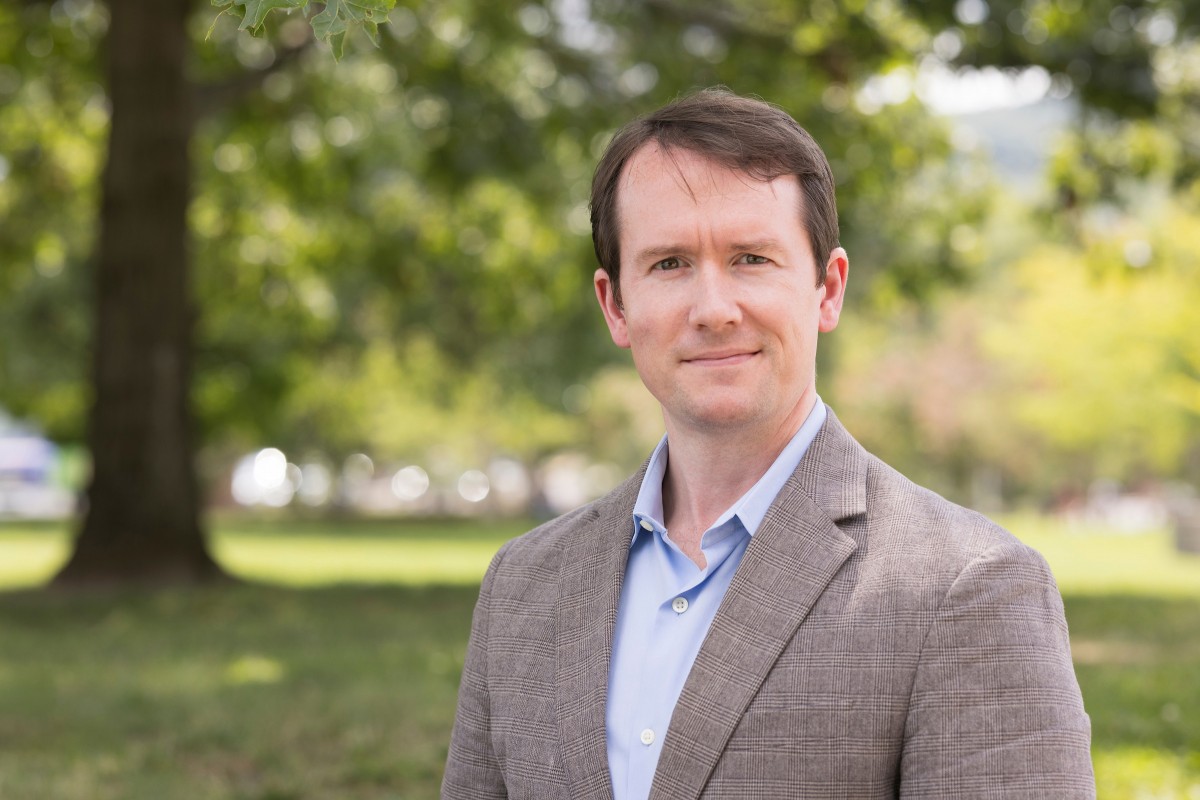Into the depths: New book explores water symbolism in German literature
Alexander Sorenson explores the role of the environment in 19th-century cultural consciousness

Everyone drowns in German Realist literature.
All right, maybe not everyone. But in text after text, characters slip under the water — claimed by river, flood or sea — never to be seen again. All that drowning must symbolize something, but what?
Binghamton University Lecturer of German and Comparative Literature Alexander Sorenson pieces together the puzzle of meaning in his new book, The Waiting Water: Order, Sacrifice, and Submergence in German Realism (Cornell University Press).
When he began to read German literature as an undergraduate, Sorenson was struck by how often characters drowned. No one seemed to know why, and his professor encouraged Sorenson to research the topic. His junior-year term paper eventually sparked a doctoral dissertation, which gave rise to the book.
“It’s more than just a motif that pops up here and there; it’s not just a flourish,” he explained. “I suspected that there has to be something central about it.”
His analysis focuses on 19th-century texts by Adalbert Stifter, Gottfried Keller, Marie von Ebner-Eschenbach, and Theodor Storm, along with material from earlier and later epochs. What emerged during his research was the intersection of literature with the natural environment and the role the environment plays in social consciousness.
“It’s shocking how prevalent it is and how unrestricted water is as a symbolic resource,” Sorenson said. “It’s self-consciously experimental.”
Law and sacrifice
During the 19th century, German-speaking lands were undergoing industrialization — which, along with realistic literature itself, came years after similar developments in England and France.
Compared with much English and French realism, which often focuses on urban life, the natural environment plays a distinct role in German Realist literature—not just as a setting but as a character in its own right. Typical realist concerns with mass society and industrialism are there, but they play out in different ways, Sorenson said.
“There’s definitely a relationship with the onset of industrialized capitalism,” he said. “The environmental impacts weren’t immediately obvious in the same way as England, where the countryside had been transformed from the 18th century onward.”
Drowning occurs in English—and French-language literature as well, but it often derives from a cultural fascination with the figure of Ophelia from Shakespeare’s Hamlet.
“While Ophelia was present and played a role in the later part of the 1800s and especially in the early 1900s, it was more complicated than that,” he said of the German motif overall. “In the German literary tradition, and especially realism, one way to put it is that everybody drowns. You have people of all ages, men and women, non-human creatures. It’s really all over the place.”
However, young people seem particularly susceptible to this fate in German literature; one of the earliest texts Sorenson explores is a novel by Goethe that features the death of a child. Nor is feminine melancholy — as seen with the Ophelia trope — the sole driver behind German literary drownings.
Instead, the motif revolves around dual concepts of order and sacrifice, Sorenson argues.
Sacrifice is traditionally viewed as a violent or destructive process used to appease a higher power and atone for individual or collective guilt. The ultimate goal is to reestablish a balance between the earthly world and the divine, he said. That’s not how the theme played out in the texts, however.
“In addition to the expansion of the sociocultural and gender dynamics of the drowning motif, what surprised me was the way that sacrifice operated, and what it actually meant,” he said. “What I ended up arguing in the book was that in German Realism, sacrifice is more of an ethical process; it deals with ethical and moral dilemmas of decision and choice, specifically with relinquishing or surrendering one thing for the sake of something else.
Often, it’s the self, offered up for the sake of someone else or for a specific social good (and sometimes vice versa), a concept tightly interwoven with questions of lawfulness.
In these narratives, that process “consistently plays out ultimately near or in water. It surprises you as a reader and forces you to rethink what law and sacrifice actually mean and what they look like,” he said.
These events occur almost invariably on the edges of communities, such as rivers that separate a town from the broader landscape; to become submerged is to disappear into the periphery of society.
In his current project, Sorenson continues to focus on nature in 19th-century poetry, theology and philosophy, particularly the natural world as a sacramental space. There, nature is not regarded as divine, nor as a mechanistic set of forces and processes devoid of spirit, a view that became common with the scientific revolution.
“There’s this fleeting middle space where nature becomes a point or a zone of encounter between the material and the mechanistic, the inanimate and the sacred,” he explained. “Nature is the place where those two things come into contact with each other.”
It’s a surprisingly modern message, one that feels deeply relevant to today’s environmental movement, he said.
“I’m doing the same literary, interpretive work, but trying to put that in the service of practical ways to think about the natural world now and translating that into behavior, habits and modes of engagement,” he said.

